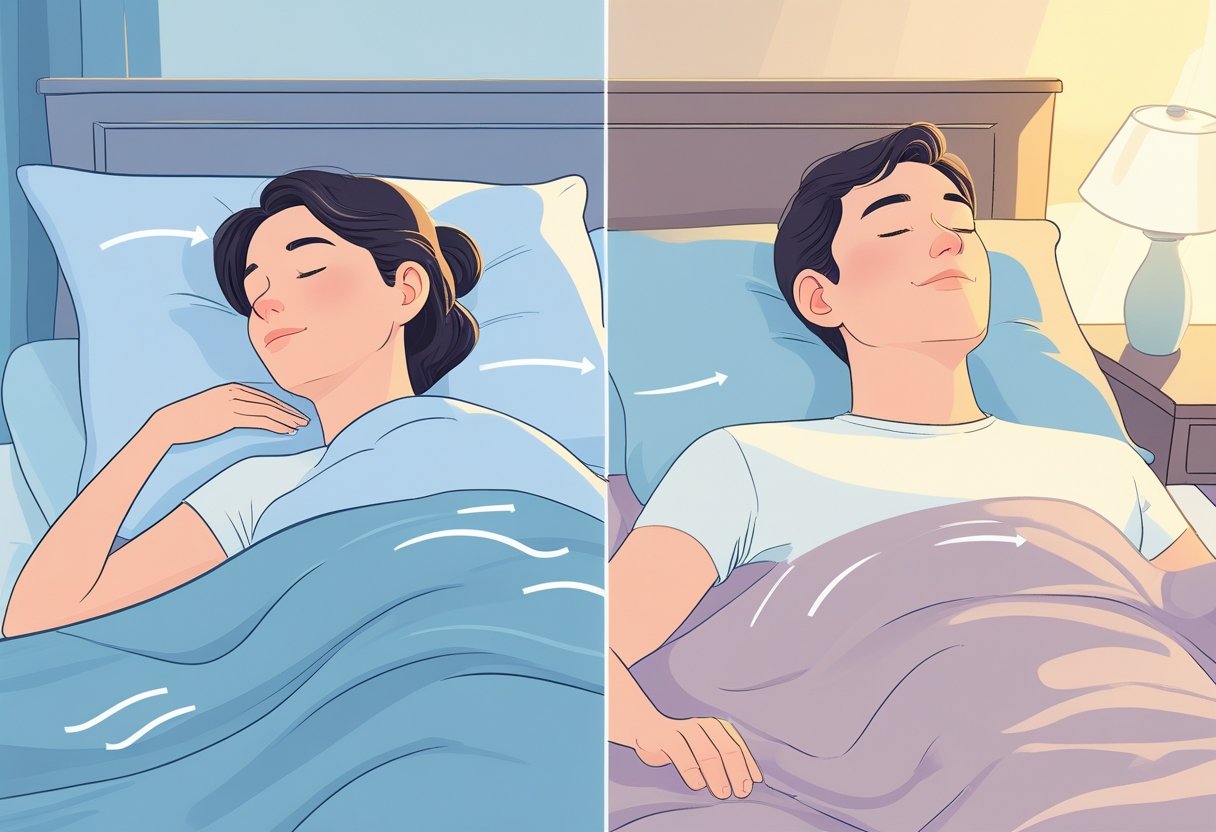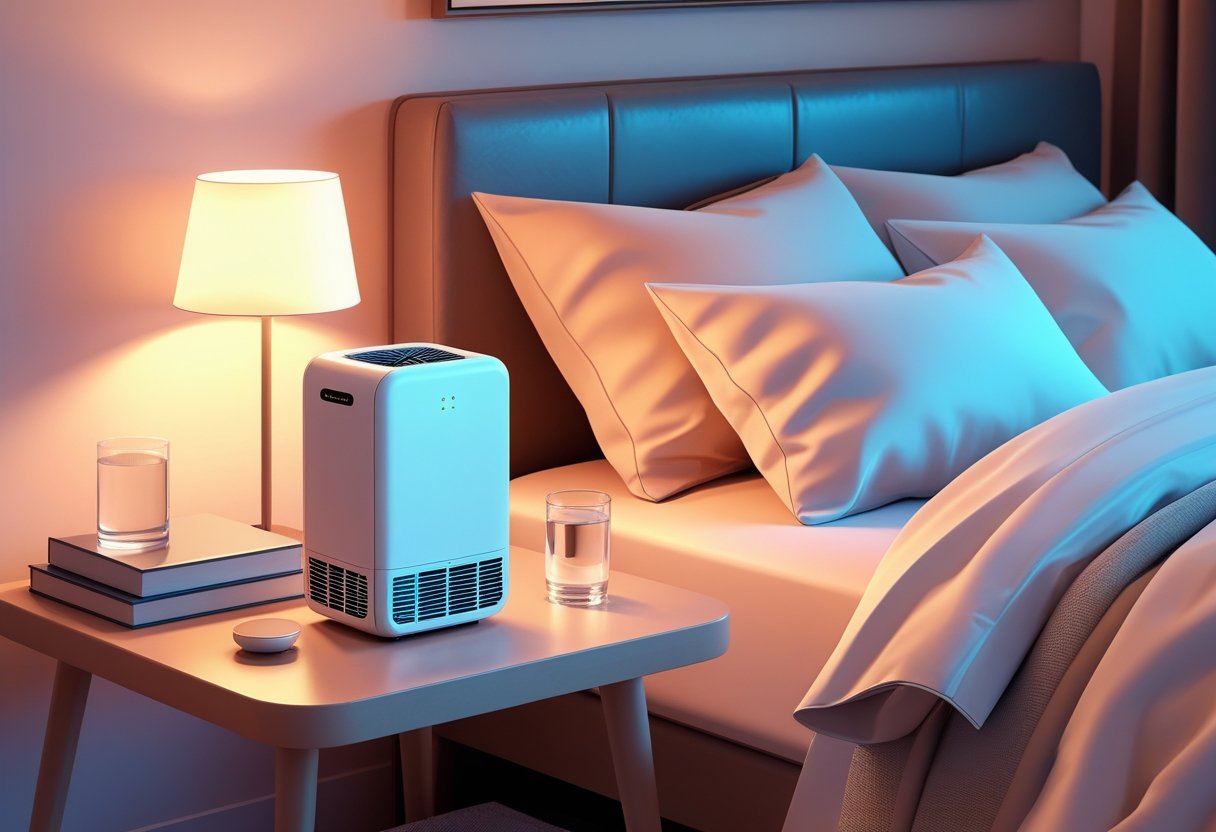Sleeping with asthma can be tough because symptoms often get worse at night. That’s why the way you sleep matters. The best positions are either lying on your back with your head and shoulders slightly raised or resting on your left side with proper support. These positions help keep your airways open and make breathing easier.
On the other hand, lying on your stomach or right side may cause your airways to tighten, leading to coughing and discomfort. Your sleep setup also plays a role. Keeping the bedroom free of dust, allergens, and extreme temperatures can reduce triggers that disturb your rest.
Finding the right position and environment can make a big difference. Better sleep means fewer wake-ups in the middle of the night and more energy during the day. Here are some key points to remember if you’re dealing with asthma and want better sleep.
Key Takeaways
- Sleeping on your back with your head slightly elevated or on your left side helps ease asthma symptoms.
- Avoid sleeping on your stomach or right side to prevent restricted breathing.
- A clean, allergen-free bedroom at a comfortable temperature supports better rest.
- Choosing a mattress that reduces allergens and allows steady airflow can improve breathing throughout the night.

Why Sleep Is Challenging With Asthma

Asthma doesn’t just affect the day. For many people, it shows up at night and makes it hard to get good rest. Symptoms often get worse while sleeping, which means more waking up, more tossing around, and less real recovery. The reasons vary, but they usually involve how the body reacts at night, triggers hiding in the bedroom, and the way poor sleep affects overall health.
Nocturnal Asthma
Nocturnal asthma is the term for nighttime flare-ups. Common signs include coughing, wheezing, chest tightness, and shortness of breath. These don’t just make you uncomfortable, they break up sleep, sometimes waking you up suddenly in the middle of the night. This happens enough that many people with asthma expect it every week.
While asleep, the airways may become more sensitive, swollen, or clogged with mucus. The muscles around them also tighten, which makes it even harder to breathe. Because asthma behaves differently at night than during the day, it’s important to notice patterns and manage symptoms before they spiral.
Impact of Nighttime Triggers
Bedrooms carry a lot of triggers people don’t always think about. Dust mites, pet dander, pollen, and mold can collect in sheets, pillows, and even furniture. Breathing these in at night can quickly irritate the airways and set off asthma.
Air quality matters too. Very cold or dry air can tighten the airways and cause coughing fits. Simple changes, like using protective covers for mattresses, washing bedding often, or adding a humidifier, can make a big difference. Acid reflux is another issue. Lying flat sometimes allows stomach acid to rise into the throat, which can make symptoms worse. Managing these triggers is often the first step to better nights.
The Importance of Quality Rest
Good sleep matters for everyone, but for people with asthma it’s even more crucial. Broken sleep weakens the body’s defenses, drains energy, and can even lower lung function during the day. The cycle is tough: poor sleep makes asthma worse, and worse asthma keeps you from sleeping. Better routines can help break this cycle. A regular bedtime, a clean sleeping space, and certain sleep positions like lying on the left side or keeping the head slightly raised can ease nighttime breathing.
Quality rest not only helps at night but also makes daytime asthma easier to control.
Best Sleeping Positions for Asthma Relief
Sleep positions can affect how well you breathe at night. Certain positions keep the airways open and lower pressure on the lungs, which makes it easier to manage asthma. Good posture while sleeping can also reduce triggers like acid reflux, a common cause of nighttime flare-ups.
Left Side Sleeping
Sleeping on your left side is usually recommended if you have asthma. This position can lower acid reflux, which is one of the main triggers that makes asthma worse at night. Gravity helps keep stomach acid from moving up into the throat, so the airways stay calmer. It may also help lung function by keeping the airways open and improving blood flow.
Many people say they feel more comfortable breathing on their left side. Adding a pillow between your legs keeps your spine aligned and prevents discomfort while you rest.
Back Sleeping With Elevated Head
Another option is sleeping on your back with your head and shoulders raised. Elevation makes it easier for air to move through the airways and helps mucus drain, which lowers coughing and congestion.
A wedge pillow or stacking a few pillows can support the upper body and prevent airways from getting blocked. Keeping the knees slightly bent with a pillow under them improves circulation and stops you from rolling into positions that can trigger symptoms. This setup is also useful for people who have both asthma and sleep apnea. What you should avoid is lying flat on your back, since that can make breathing harder.
Pillows for Support and Comfort
Pillows are also important in keeping the body stable during sleep. They stop you from moving into positions that block airways and help you stay comfortable. For back sleepers, using two or three pillows under the head and shoulders keeps the airways open. For side sleepers, a pillow between the legs keeps the spine straight, reduces strain, and supports better lung function.
Choosing firm pillows made with natural materials like cotton can also reduce exposure to allergens that can trigger asthma. Using the right pillows helps you stay in safe and comfortable positions through the night.

Positions to Avoid When Sleeping With Asthma
Certain sleep positions worsen asthma symptoms by narrowing airways or causing mucus buildup. Avoiding these positions helps reduce wheezing and improve breathing at night.
Sleeping on the Right Side
Lying on the right side makes it harder to breathe for many people with asthma. This position can narrow the airways because it affects the vagus nerve, which plays a role in airway constriction. Studies show that resting on this side activates the parasympathetic nervous system, which makes the airways tighten.
For a lot of people, this leads to wheezing or shortness of breath, especially at night. While not everyone reacts the same way, it’s common for symptoms to feel worse in this position. People with asthma may want to avoid sleeping on their right side or notice whether symptoms improve when they try a different position.
Flat on the Back or Stomach
Lying flat on the back without raising the head can make asthma symptoms worse. Mucus may build up in the airways and block airflow, which makes it harder to breathe. This position increases nighttime wheezing and overall discomfort. Sleeping on the stomach is usually the worst option. It puts pressure on the chest and lungs, limiting airflow. It also prevents the head from staying elevated, which is important for clearing mucus and making breathing easier.
For people with asthma, keeping the head and shoulders raised helps keep the airways open. This position can cut down on nighttime coughing and wheezing, which makes it easier to rest.

How to Prevent Asthma Attacks at Night
Preventing asthma attacks at night starts with keeping the bedroom environment under control and staying on top of medication. A clean sleeping space and the right treatment routine can lessen symptoms and help improve sleep.
Bedroom Triggers
Allergens in the bedroom like dust mites, pet hair, and mold are common reasons why asthma gets worse at night. Keeping the room clean makes a big difference. Some helpful steps include:
- Use an air purifier near the bed.
- Wash sheets and pillowcases in hot water every 1–2 weeks.
- Choose cotton sheets instead of synthetic fabrics.
- Keep pets off the bed, especially overnight.
- Keep the room slightly warm since cold air can tighten the airways.
Fresh airflow in the bedroom also prevents triggers from building up. Avoid smoke and strong odors in or near the room because they can irritate the lungs and make symptoms worse.
Nighttime Medication Management
Having medication within reach at bedtime is important. Inhalers or other prescribed devices should be placed by the bed for quick use if symptoms start during the night. Sticking to daily controller medication as instructed by a doctor lowers the chance of sudden flare-ups.
If symptoms show up at night, using a reliever inhaler right away can help open the airways. It’s important not to skip or delay doses, even when symptoms seem better. Regular check-ups with a healthcare provider also matter, since treatment plans may need adjusting if nighttime attacks happen often.

Optimizing the Sleep Environment for Asthma

Creating a bedroom that limits irritants and feels comfortable can make a big difference for people with asthma at night. The main things to look at are allergen control, clean air, and proper humidity. Bedding choices and pet rules also matter if you want better sleep with fewer breathing problems.
Allergen Reduction and Air Quality
Keeping allergens out of the bedroom lowers the chance of nighttime asthma attacks. Washing sheets and pillowcases in hot water once a week gets rid of dust mites and other triggers. An air purifier near the bed can help filter pollen, pet dander, and small dust particles.
If the outdoor air is clean, opening the window for fresh air can help. Vacuuming floors often and wiping down surfaces also keep allergens from building up. Cotton bedding is usually better than synthetic fabrics since synthetics can trap allergens. Keeping the bedroom clutter-free also helps cut down on dust.
Humidity and Temperature Control
The right level of humidity makes breathing easier. Too much moisture encourages mold and dust mites, while air that’s too dry can irritate the airways. The ideal range for people with asthma is usually between 30% and 50%.
Room temperature also matters. A space that’s too cold, especially below 65°F (18°C), can tighten the airways. Keeping the room at a steady, moderate temperature helps reduce nighttime wake-ups. A humidifier or dehumidifier can be used when needed to keep humidity balanced and the airways relaxed.
Pet Management and Bedding Options
Pets in the bedroom can add allergens that make asthma worse. Keeping them out of the room prevents dander from settling on furniture and bedding. Grooming pets regularly also lowers the amount of loose hair and allergens in the home.
Bedding plays a role too. Hypoallergenic covers for pillows and mattresses help block dust mites and other allergens. Cotton is usually the safest fabric choice, while feather and synthetic bedding can hold onto triggers. Washing bedding weekly in hot water adds another layer of protection. These steps work together to create a cleaner sleep space, which means fewer asthma flare-ups and better rest.
Breathing Techniques and Lifestyle Tips for Better Sleep

Nighttime asthma can make it hard to get proper rest, but small changes in breathing and daily habits often bring relief. Simple routines help calm the body, ease wheezing, and make sleep less interrupted. These steps don’t replace your medicine, but they work well alongside it to make nights easier to manage.
Methods to Breathe Better During Nighttime
Controlled breathing is one way to settle the lungs when symptoms appear. A common method is the 4-7-8 technique:
- Breathe in through your nose for 4 seconds
- Hold your breath for 7 seconds
- Exhale slowly through your mouth for 8 seconds
This type of breathing slows the heart and relaxes the chest, which can make breathing feel less tight. Breathing through the nose instead of the mouth also keeps the airways from drying out. Doing this regularly before bed helps the body get used to the rhythm, though it should always be seen as support, not a replacement for prescribed treatment.
Coping With Wheezing and Discomfort
If wheezing starts while you’re asleep, sitting upright can help until your inhaler or other medication takes effect. Propping up the head and shoulders with pillows gives the lungs more room to expand. It’s also smart to keep your inhaler close to the bed so you can reach it right away if symptoms get worse.
Your sleeping space can influence too. A clean room with fresh sheets, steady temperature, and less dust or pet dander reduces the chances of a flare-up. For people who sleep on their side, placing a pillow between the knees can improve posture and make breathing less strained. Combined with proper medicine, these habits help cut down on restless nights and make sleep more consistent.
When to Seek Medical Guidance
Asthma symptoms can show up more often during the night, and sometimes they can be serious. Knowing when to get medical help is important to avoid bigger health problems. This section explains what signs to watch for and what might happen if nighttime asthma is left untreated.
Identifying Signs of Risky Night Symptoms
Waking up frequently with wheezing, coughing, or trouble breathing is a warning sign that asthma is getting worse. Feeling tightness in the chest or like you’re choking during sleep should not be ignored. Medicine usually helps quickly, but if it doesn’t, the episode may be more severe.
If asthma makes it hard to speak or causes lips and fingers to turn blue, it’s an emergency. These are signs of low oxygen and blocked airways. Needing to sit up or use extra pillows just to breathe is another sign that the current treatment or sleep setup isn’t working well.
Risks of Untreated Nocturnal Asthma
Ignoring asthma symptoms at night raises the risk of a serious attack, which can sometimes be life-threatening. During sleep, the airways may narrow, making it hard to breathe and lowering oxygen levels. In rare cases, untreated asthma attacks at night can even lead to death while asleep.
Nighttime asthma also affects daytime life. Poor sleep can leave a person tired and unable to function fully. Adjusting sleeping position or bedroom setup may help, but if symptoms keep happening, a doctor should review the treatment plan. They may adjust medications or suggest changes to improve breathing and safety at night.
Mattress Choices That Support Better Sleep for People With Asthma
People with asthma know how much the environment affects their breathing. A mattress isn’t just about comfort, it can also make symptoms better or worse. The wrong materials can hold dust, mold, or pet dander, while the right ones can cut those triggers down. That’s why beds made with hypoallergenic materials are safer choices.
Memory foam is a strong option since its dense surface makes it harder for allergens to get trapped inside. Hybrids are another good pick because they mix foam with coils and often use breathable covers. Those covers help air move through the mattress and stop moisture from sitting too long, which means less chance for mold to grow.
Another thing worth paying attention to is certification. It shows that the mattress foam doesn’t have harsh chemicals that might cause irritation. Some mattresses also come with antimicrobial or dust-mite resistant covers, which adds another layer of protection for anyone trying to keep their sleep space clean.
Top mattress features for asthma patients are:
- Hypoallergenic materials – better for sensitive lungs
- Memory foam layers – keeps dust mites and allergens away
- Breathable, antimicrobial cover – less mold and bacteria
- Low VOC emissions – fewer chemical triggers
- Medium to medium-soft firmness – easier to rest and breathe comfortably
It’s smart to stay away from beds that have been treated with heavy chemicals or use coarse fabrics. While natural latex can work well for some, it can still cause a reaction in others. A trial period is always useful because it gives you time to see if the mattress really works for you before making a final choice.
If you’re also thinking about sustainability, the Nolah Natural 11” Mattress is one option to check out. It’s made with organic latex and cotton and has a breathable design that lets air flow through. That setup makes it a good fit for someone who wants both comfort and fewer asthma triggers. This mattress avoids synthetic chemicals and naturally pushes back against dust mites and allergens. At the same time, it offers solid pressure relief and long-term support. In short, it creates a healthier sleeping space where breathing feels easier and rest comes more naturally.

Frequently Asked Questions
There are different habits and small changes that can help ease asthma at night. Adjusting your sleeping position, using the right tools, and avoiding triggers are often the most helpful steps.







